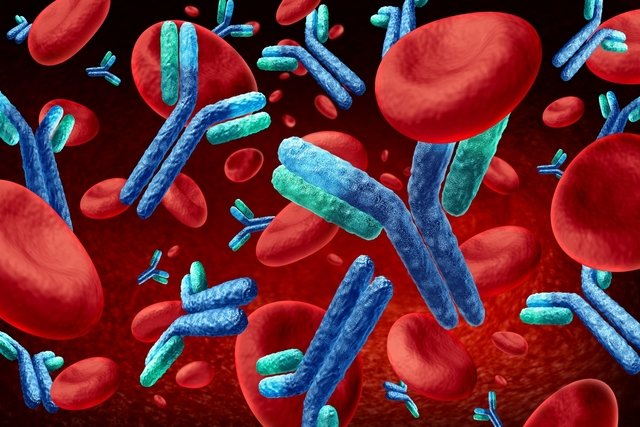Immunoglobulin A, known mainly as IgA, is a protein found in large quantities in mucous membranes, mainly in the respiratory and gastrointestinal mucosa, and can also be found in breast milk, and can be passed on to the baby during breastfeeding and help in the development of immune system.
This immunoglobulin’s main function is to defend the body and, therefore, when in lower concentrations, it can favor the development of infections, which must be identified and treated according to the doctor’s instructions.

What is IgA for?
IgA’s main function is to protect the body against infections and can initially be obtained through breastfeeding, in which the mother’s immunoglobulins are transmitted to the baby. This protein can be classified into two types according to its location and characteristics, and may have different functions that are important for the body’s defense:
- IgA 1which is mainly present in serum and is responsible for immunological protection, because it is capable of neutralizing toxins or other substances produced by invading microorganisms;
- IgA 2, which is present in mucous membranes and is found associated with a secretory component. This type of IgA is resistant to most proteins produced by bacteria that are responsible for destroying the body’s cells and, therefore, corresponds to the first line of defense against infectious agents that enter the body through the mucous membranes.
Immunoglobulin A can be found in tears, saliva and breast milk, and is also present in the genitourinary, digestive and respiratory systems, protecting these systems against infections.
Normal IgA values
The values of immunoglobulin A in the blood vary according to the person’s age and the laboratory in which the test is carried out, and may be:
For the immunoglobulin A test in saliva, values for adults can vary from 2.0 to 8.0 mg/dL.
What can be high IgA
An increase in IgA can occur when there is a change in the mucous membranes, especially in the gastrointestinal and respiratory mucosa, as this immunoglobulin is mainly found in this location. Thus, the amount of IgA may be increased in the case of respiratory or intestinal infections and liver cirrhosis, for example, and it may also change in the case of skin or kidney infections.
It is important that other tests are carried out, such as a complete blood count, total blood protein test or urine test, to identify the cause of high IgA and thus initiate the most appropriate treatment. Find out how the total blood protein test is performed.
What can be low IgA
The decrease in the amount of circulating IgA is normally genetic and does not lead to the development of symptoms related to this change, being considered a deficiency when the concentration of this immunoglobulin is lower than the IgA reference values in the blood.
However, the low amount of this immunoglobulin circulating in the body can favor the development of diseases, since the mucous membranes are unprotected. Therefore, in addition to being reduced due to genetic factors, IgA deficiency may also be present in the case of:
- Immune changes;
- Asma;
- Respiratory allergies;
- Cystic fibrosis;
- Leukemia;
- Chronic diarrhea;
- Malabsorption syndrome;
- Newborns with rubella;
- People who have undergone bone marrow transplantation;
- Children infected with the Epstein-Barr virus.
Normally, when there is a decrease in IgA, the body tries to compensate for this decrease by increasing the production of IgM and IgG with the aim of fighting the disease and keeping the body protected. It is important that in addition to the IgA, IgM and IgG measurements, more specific tests are carried out to identify the cause of the change and, thus, initiate the most appropriate treatment. Learn more about IgM and IgG.
Bibliography
- MINISTRY OF HEALTH – CENTRAL ADMINISTRATION OF THE HEALTH SYSTEM. Reference Laboratory Values. Available at: <http://www.acss.min-saude.pt/wp-content/uploads/2018/09/tabela.pdf>. Accessed on Jul 23, 2021
- CITOLAG. IgA – Immunoglobulin. Available at: <http://citolag.com.br/Man_I.pdf>. Accessed on Jul 23, 2021
- GLUE TAINED, S.; et al. High concentration of immunoglobulin A is associated with temporal lobe epilepsy. Epilepsy Res. 103. 1; 54-61, 2013
- J PEDIATR (RIO J) 1998;74(6):433-40. IgA deficiency. Available at: <http://www.jped.com.br/conteudo/98-74-06-433/port.asp>. Accessed on Jul 23, 2021
- SEOANE, Elena, FROM ABOVE, Sonia. Diagnosis and management of primary immunodeficiencies in children. Spanish Association of Pediatrics. 2; 415-435, 2019
- BRITISH SOCIETY FOR IMMUNOLOGY. Immunoglobulin A (IgA). Available at: <https://www.immunology.org/file/102/download?token=WEEslTcM>. Accessed on 03 Sep 2020
- PATEL, AJAY; JIALAL, ISHWARLAL. Biochemistry, Immunoglobulin A (IgA). Available at: <https://www.ncbi.nlm.nih.gov/books/NBK551516/>. Accessed on 03 Sep 2020
- BIOSYSTEMS. Immunoglobulin A (IgA). Disponível em: <http://www.biosystemsne.com.br/files/product/f2f042781af1d2968fd79f0ca5dcb205.pdf>. Acesso em 03 set 2020
- AROSA, Ferdinand A.; CARDOSO, Elsa M.; PACHECO, Francisco C. Fundamentals of Immunology. 2 ed. Lisbon: LIDEL, 2012. 202-203.
- BARER, Michael R. et al. Medical Microbiology – A guide to Microbial Infections: Pathogenesis, immunity, laboratory investigation and control. 93. Elsevier, 2018. 633.

Sign up for our newsletter and stay up to date with exclusive news
that can transform your routine!
Warning: Undefined array key "title" in /home/storelat/public_html/wp-content/plugins/link-whisper-premium/templates/frontend/related-posts.php on line 12
Warning: Undefined array key "title_tag" in /home/storelat/public_html/wp-content/plugins/link-whisper-premium/templates/frontend/related-posts.php on line 13



